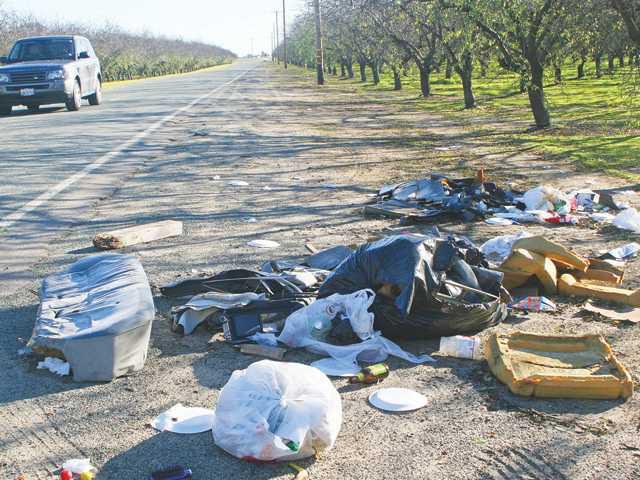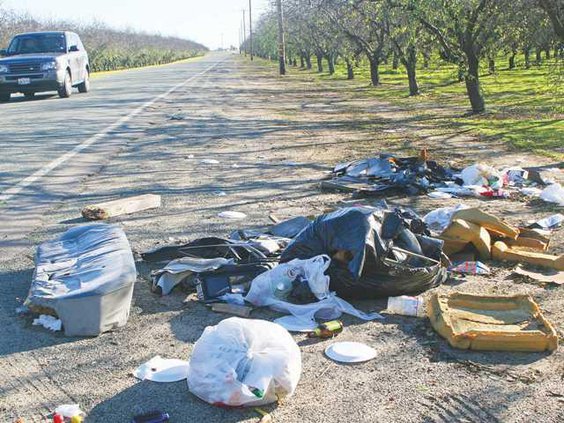Trash is not cheap. Especially when it’s illegally dumped on roadsides and San Joaquin County workers have to do the clean-up.
Latest figures from fiscal year 2014-2015 show that San Joaquin County spent $731,000 removing garbage illegally dumped on roadsides. Between labor, equipment, overhead expenses, and disposal fees at the landfill, that’s how much taxpayers’ money is being spent every year to remove illegally dumped garbage on county right-of-way roads and other tasks by the Road Maintenance Division of the county’s Public Works Department.
The county is actually spending more money on roadside illegal dumping than ditch clearing, bridge repairs — guard rails being knocked down, for example — and tree removal, said Director of Information Jim Stone.
This perennial problem is such that this clean-up work has become “pretty much year-round,” Stone said, with a crew devoted to doing this type of clean-up.
“One truck and one crew does that year-round; a crew of two men does that pretty much full time. They are out there every day,” with additional personnel called in sometimes to assist, added Stone who worked for the City of Manteca Public Works until he went to work for the county three years ago.
Additional workers are called upon to help when the removal and clean-up job needs more than two pairs of hands to get it done, Stone said of the situation which one described as an “out-of-control” problem.
Boats, refrigerators, recliners, doors, dressers, and mattresses
A drive around the Manteca, Ripon and Lathrop countryside alone at any time reveals a wide variety of garbage left by anonymous subjects, most of them right next to fields of row crops, vineyards, and fruit and nut orchards. They range from large items such as boats, refrigerators, large-screen television sets, mattresses of all sizes, toilet bowls, recliners, doors, dressers, plastic chairs, car tires, and headboards to smaller trash stashed inside large garbage bags that include clothes, children’s plastic and stuffed toys, kitchen gadgets, linens, and tools of all kinds. Many times, these things are simply scattered all over the side of the road. Such is the case on South Austin Road between East Highway 120 and the 99 overpass next to a vineyard.
On South McKinley Avenue between the 120 Bypass and Woodward Avenue are several roadside locations where trash has piled up in the last few weeks. Next to an alfalfa field, someone has set up an al fresco setting of recliner, a queen-size mattress with bedspread still wrapped around it, and a large television set. The site started out with two television sets but the smaller one disappeared a few days later. The large TV set, through the last few weeks, has been incrementally picked apart starting with the disappearance of the monitor.
Just a few feet south of this trash pile are several black bags of trash lying on the ground partially covered by alfalfa. To the north, underneath the 120 Bypass on both sides of McKinley Avenue are piles of the same — various types of trash simply scattered all around the place.
Earlier this year, during winter, two boats were dumped on South Manteca Road just yards apart. The trashed watercraft left next to an almond orchard was abandoned on the east side of the road. The other one not too far away across the road was abandoned on the west side of the road next to an irrigation ditch.
What residents
can do to help
Is there something residents can do to help eradicate or even, at least, minimize this perennial problem that appears to be going out of control? Being vigilant to these illegal actions is one, Stone said.
If you see someone doing illegal dumping, “Call 911; that is a crime in progress. If they see someone dumping, call 911 and the Sheriff will respond,” Stone said.
While there is a dedicated crew assigned to remove all illegal trash, residents can also call the county Public Works’ Roadside Maintenance Division to report a specific location and crews can do a complaint-based clean-up.
The other solution is for residents to take their trash to the county Lovelace Road transfer station and “get rid of it properly” for a fee of $20 per pick-up load, Stone said.
“We have very convenient hours, and we’re open seven days a week. We keep prices down to make it convenient for people to bring (the trash) to us,” he said.
For the convenience of residents who live in South San Joaquin County, they can bring their trash loads to the Tracy Materials Recovery Facility on McArthur Drive about five miles south of 11th Street.
This is a private company contracted by the county as a transfer station, so “the rates are slightly different,” but it’s a convenient place for residents to bring their unwanted trash. “No need to dump it on the road,” Stone said.
The Tracy facility is closed on Sunday and open Monday to Saturday. The Lovelace Station located north of Lathrop Road on Lovelace Road which runs between Airport Way and Union Road is open seven days a week.
TRASHING SJ COUNTY
Removal of illegally dumped trash costs SJ taxpayers $731K annually




